Key Takeaway
Voice integration boosts user convenience; it lets users book, manage, and track handyman services through simple spoken commands, reducing manual effort and saving time.
Enhances accessibility and inclusivity, users of all ages and abilities can easily use the app, creating a wider, more loyal customer base.
Increases retention and engagement, hands-free interaction builds habitual use, improving customer satisfaction and repeat bookings.
Gives a strong competitive edge, voice-enabled handyman apps stand out in a $5.2B market projected by 2033, signaling innovation and user-centric design.
Future-ready with AI and NLP, integrating voice with smart devices like Alexa or Google Home aligns the app with evolving user behavior and IoT trends.
Partnering with JPLoft, as a leading app development company, JPLoft ensures seamless voice integration with AI-powered interfaces that enhance performance, personalization, and scalability.
"The future belongs to those who design experiences that feel effortless."
That’s exactly where voice technology comes in. The way people interact with apps is shifting, from tapping and typing to simply talking.
Voice integration in handyman apps explores how this simple shift is reshaping on-demand service apps into smarter, faster, and more human-centered tools.
For investors and entrepreneurs, this blog serves as a practical guide to understanding why voice-enabled handyman apps are becoming a profitable investment.
It highlights the competitive edge, user retention benefits, and long-term scalability that come with adopting this technology.
So, what are the benefits of implementing voice integration in handyman apps?
It enhances user convenience through hands-free booking, improves accessibility for all user types, and builds stronger engagement by creating natural, conversational experiences that boost loyalty and drive growth.
Let’s explore the details in this blog.
Rise of Voice Integration in the Current Era
Before you understand the role of voice commands in the handyman apps, let’s evaluate how voice integration has come into existence and is changing the current landscape.
The voice integration trend is revolutionizing the way individuals interact with apps across sectors. Instead of typing and tapping, users have begun issuing commands by voice to book, search, or organize tasks with ease.
This voice-controlled interaction is becoming increasingly habitual, thanks to digital assistants like Alexa, Siri, and Google Assistant.
For companies, it translates to building quicker, more natural experiences that align with how users communicate. Voice technology isn’t just a convenience; it’s changing expectations.
People now prefer apps that respond instantly, understand context, and feel conversational. As accuracy improves through AI and NLP, voice-enabled interfaces are driving higher engagement, accessibility, and retention.
From booking services to managing tasks, voice integration is making interactions more human and efficient, pushing app developers to rethink design and functionality. The change foretells a future where voice becomes the default input mode, altering how people engage with technology daily.
When it comes to handyman apps, the voice integration can increase user experience by providing a hands-free booking facility.
Let’s learn more about the benefits of voice integration in handyman apps in the following section.
Benefits of Voice Integration in Handyman Apps
When you create a handyman app, it's significant to register the use of updated technologies for improving overall performance and user experience.
If you are unaware of the voice integration benefits for the handyman apps, here is a brief to consider.
1. Quicker and Simpler Bookings
Voice integration allows users to request services directly without typing or flipping through several screens.
To say "Book a plumber nearby" or "Find an electrician tomorrow" feels quicker and more natural. Hands-free flow minimizes friction in the booking process and increases conversions.
When users spend less time searching and more time doing, engagement rates increase dramatically. Busy users will find this convenience an edge in deciding which app to use.
2. Hands-Free Convenience
One of the crucial benefits of Voice-enabled handyman apps is to simplify life for users who can't easily type, are holding tools, multitasking, or just have physical limitations.
Rather than scroll, they can just talk and accomplish things. It's how this handyman app design makes the application more inclusive and addresses audiences that traditional designs miss.
Accessibility isn't a nice-to-have feature; it's now a competitive requirement.
3. Richer User Experience
A voice-integrated interface adds a human touch to digital interactions. Instead of buttons and forms, users converse naturally with the app, making it feel intuitive and personal.
Responses like “Your booking is confirmed for 6 PM” or “Would you like the same technician as before?” mimic real conversation. This familiarity keeps users engaged longer and builds trust.
4. Improved Personalization Through AI
As customers talk, the system picks up context, tone, urgency, and purpose. AI in handyman apps can leverage this information to personalize recommendations, such as providing quicker service slots or suggesting regular maintenance.
As the app learns over time about personal habits and tendencies, it makes wiser recommendations. This personalization enriches customer satisfaction and encourages repeat bookings.
5. Smooth Integration with Smart Devices
As assistants and smart speakers become increasingly popular, handyman apps with voice functionality can easily be integrated with Alexa, Siri, or Google Assistant.
Users can simply say, "Hey Google, book a handyman for 5 PM," and the app will do the rest. This integration into the smart-home ecosystem increases convenience and sets your app up for the future of connected life.
6. Higher Booking Retention Rates
Voice integration in handyman apps cuts steps between desire and action. This brings users back. When it's easy to book, users don't go elsewhere.
Habit loops formed through repeated voice interactions also create stronger retention. The simpler the interaction, the more likely users are to remain loyal to your platform.
7. Time Efficiency for Service Providers
Voice commands not only benefit customers, but tradespeople can also take advantage
Technicians can utilize voice commands to report job status, review schedules, or send brief confirmations without even laying their hands on their phone.
Voice integration in handyman apps saves time with heavy workloads and enhances overall efficiency. It also helps facilitate smoother communication between customers and service providers.
8. Real-Time Support and Notifications
Another benefit of voice integration in handyman apps is that consumers can query the application regarding current bookings, "Where is my technician?" or "When is the cleaner coming?", and receive instant answers.
Voice feedback provides an instantaneous support mechanism, minimizing the need for manual checks. This real-time exchange establishes transparency and trust, two key drivers of consumer satisfaction.
9. Multi-Language Support
With AI-driven voice technology, handyman apps can handle regional accents and languages with ease. Users can use their native language, and the system interprets it into executable commands.
This makes for an inclusive feature that appeals to a wide range of audiences and makes users more comfortable. A multilingual voice interface can be a significant differentiator in local markets.
10. Competitive Market Advantage
In a projected market of over $5.2 billion by 2033, voice integration is not a fad; it's a growth opportunity. Intelligent, hands-free experiences through apps differentiate your app from run-of-the-mill service platforms.
Early mover advantage creates brand equity and user loyalty, providing your app with a long-term competitive advantage.
Hence, it can be stated that the voice integration in handyman apps enhances the overall user experience and helps the brands to retain the users in the long run.
Now, let’s consider the role of voice commands in the handyman apps in the next section.
How Voice Integration is Transforming Handyman Apps?
Voice integration in handyman apps does play an important role in enabling users to book, search, and even manage hands-free booking through commands to smart assistants such as Alexa or Google Assistant, which results in improving the convenience and accessibility.
When you start an online handyman business, remember to evaluate the role of voice integration that enhances user engagement by allowing faster interactions for multitaskers.
Let’s check out the role of voice integration in handyman apps, below.
1] Simplified Booking Experience
Voice integration removes the requirement for users to scroll, search, or type. The command "Book a plumber for tomorrow morning" initiates an instant booking.
Decision fatigue is reduced, and the user journey is shortened. The quicker and smoother experience drives increased conversion rates and raises the bar for app convenience.
2] Personalized User Interactions
AI-powered voice systems retain preferences, service history, and user behavior patterns. Over a period, they begin providing contextual suggestions such as "Would you like to rebook your last electrician?"
Such personalization creates trust and makes it more loyal, making the app more like an assistant than a tool.
3] Improved Accessibility and Inclusivity
Voice commands make handyman apps more accessible for individuals with challenges with reading or typing. It gives power to senior citizens, disabled persons, and non-technical users to book services with ease.
Such accessibility increases the reach of the app and makes it available to a larger group of people.
4] Quicker Service Management for Users and Technicians
The users are also able to monitor or adjust current jobs hands-free through voice commands such as "Check my booking status" or "Cancel my cleaning job."
Another crucial role of voice integration in handyman apps is that technicians are also able to indicate job completion or update their availability through voice commands. This two-way efficiency saves time and enhances coordination in the platform.
5] Integration with Smart Devices
While homes embrace voice assistants such as Alexa and Google Home, handyman apps can directly talk to them.
Technicians can be requested by the user without even launching the app. This puts handyman apps in the smart living ecosystem, making them relevant in the long term.
6] Real-Time Support and Updates
Voice integration allows for real-time customer support. Rather than typing on chat, users can just say, "Talk to support," or "Where is my technician?"
It is an important role of voice integration in handyman apps, where the application responds naturally, keeping customers active while answering questions efficiently. This creates trust and eliminates churn.
7] Improved Multitasking for Users
Voice interaction enables users to book or arrange services while they are busy doing something else, cooking, driving, or working. Such multitasking perfectly matches the hectic lifestyle of modern users.
It makes service booking a smooth, background process rather than a nuisance. Additionally, the voice integration in handyman apps does improve overall multitasking for the users, enabling them to book a handyman effectively.
8] Data Insights for Predictive Services
Voice interactions create rich information regarding user intent and timing. Apps are able to use this to forecast future requirements, e.g., recommending seasonal upkeep before customers even request it.
This information allows platforms to shift away from reactive service models and towards proactive engagement.
9] Increase in User Retention and Loyalty
When tasks can be completed fast, customers return more frequently. Voice-driven handyman apps provide convenience that is effortless.
It creates emotional stickiness over time; customers know the app to be reliable and convenient, and they are less likely to jump to competitors. The voice integration in handyman apps boosts the loyalty factor and helps handyman apps connect with users in the long run.
10] Brand Differentiation in a Competitive Market
In a saturated marketplace, possessing cutting-edge voice capabilities provides a handyman app with a distinct advantage.
It communicates innovation, enhances brand reputation, and draws technologically savvy consumers. Voice technology is a growth driver for businesses and startups, serving as a credibility booster and market positioning enhancer.
Well, you must have noted that the voice commands do acts as an API integration for handyman apps, enable the users to successfully select and book an handyman.
Now, as we have learned about the role, let's switch to the process of integrating voice commands in the handyman apps, below.
How to Integrate Voice Commands While Creating a Handyman App?
Whether it's about implementing gamification in handyman apps or AR in handyman apps, learning about the right process to integrate these technologies plays a vital role.
Let’s learn the process to integrate voice commands in handyman apps, below.
Step 1: Identify Core Voice Use Cases
Begin by defining what your users are going to use voice for: booking, rescheduling, tracking, or contacting technicians. Prioritize the most frequent and impactful interactions. Unclear intent mapping leads to building solutions for real user issues rather than adding novelty functionality.
Step 2: Select a Stable Voice Recognition API
Choose a voice technology for your app environment. Popular choices are Google Speech-to-Text, Amazon Alexa Skills Kit, Apple SiriKit, and Microsoft Azure Speech Services. They support real-time speech recognition, accent detection, and multi-language support, which is critical in terms of global usage.
Step 3: Develop an NLP-Driven Command System
Add Natural Language Processing (NLP) to enable your app to comprehend the context and intent of every command. For instance, if someone asks, "Book a plumber tomorrow morning," NLP splits it into actionable items: service type: plumber, and time: morning. This makes interactions smarter and more natural. You can connect with the leading NLP services to make your expertise under this step.
Step 4: Create a Conversational Flow
Plan out how your app must respond to various voice prompts. Design dialogue trees that sound natural, brief, and forgiving. Add fallback responses like "Did you mean schedule or reschedule?" to steer users if recognition goes awry. The tone must always remain friendly and professional.
Step 5: Sync with App Logic and Database
Map the identified voice commands to backend actions, for example, when a user utters "Show nearby electricians," the system invokes a search API and retrieves results from your database. Appropriate synchronization provides real-time responses comparable to user expectations.
Step 6: Optimize UI for Voice Interaction
Create a voice-first interface with speaking and tapping capabilities. Introduce visual feedback, such as progress indicators ("Booking your technician.") and microphone indicators for recording commands. Preserve accessibility considerations with clean prompts and simple microphone activation buttons.
Step 7: Test, Train, and Refine the Voice Model
A lot of handyman app testing is essential. Conduct usability testing under various accents, noise conditions, and command variations. Gather feedback to hone accuracy and intent detection. Employ ongoing machine learning training to make the system more intelligent in the long run, allowing it to learn from real-world user behavior.
Considering these steps to implement the voice commands in the handyman apps, let’s learn how the popular businesses are leading the landscape in the proceeding section.
Real Life Examples of Voice Integration in Handyman Apps
To integrate voice command technology, it is essential to know what the top handyman apps are doing in this field.
It will help you to recognize the practical benefits and evaluate the crucial results of implementing voice commands in the handyman apps.
1. Thumbtack
The thumbtack partnered with the voice assistant platforms, including Alexa and Amazon, to help users make service bookings or inquiries via voice commands. These platforms do integrate AI phone-assistant workflows for lead follow-up, enabling faster responses.
You can create an app like Thumbtack after evaluating the strategies effective for launching an app of your dreams.
2. Urban Company
The Urban Company’s architecture comprises voice commands integration. This helps their users to schedule services via voice assistants or voice-UI. This helps the brand to make the booking simpler in the context where the users’ hands are busy.
Along with this, it broadens accessibility across the user types, as the voice can be effective instead of menu navigation. To build an app like Urban Company, you should consider voice integration as one of the features to provide convenience to the users.
3. TaskRabbit
TaskRabbit has not completely promoted a full voice-assistant booking flow; however, they emphasize the smart home installation services and systems.
By building an app like TaskRabbit, you can align with smart-home setups, where the users can expect to say, “hey Google, find someone to install a smart thermostat in the home”.
4. Airtasker
Airtasker focuses on a communication infrastructure that enables voice and SMS channels between users and taskers. The company has enabled masked phone-calling, SMS alerts, and streamlined two-way communication for boosting conversions and trust among the users.
You can build an app like Airtasker by adding the feature of voice calling, which means the users and taskers can speak directly. The company is working on adding voice commands to improve the overall user experience.
After covering the case studies, are you ready to install voice commands in the handyman app?
Yes! Well, pursuing the integration, you might face prompt challenges too.
Hence, let's discover them all in the following section.
Top Challenges in Integrating Voice Technology in Handyman Apps
Learning about the challenges while building a handyman app can help in identifying the potential pitfalls and creating an effective app.
Here is the detail of the top challenges to consider.
Challenge 1: Accent and Language Differences
People talk differently depending on accent, dialect, and tone, and that's one of the most difficult barriers for voice systems.
A voice engine can mishear commands if it's not been trained for varied speech styles. To combat this, developers require multilingual NLP models and localized datasets to enhance recognition accuracy.
Challenge 2: Environmental Noise and Interference
Users of handyman apps tend to issue commands in noisy environments, bustling streets, workshops, or while multitasking.
Ambient noise might distort voice commands, triggering false commands or truncated responses. By employing noise-cancellation filters, adaptive microphones, and unambiguous confirmation queries, these errors are minimized.
Challenge 3: Data Privacy and Security Concerns
Voice information tends to carry personal or geolocation data, and privacy protection is therefore paramount. You should enable effective mobile app security to enhance trust of the users towards the app.
Insecure handling of audio files or the absence of encryption can give rise to security threats. Data privacy apps need to adhere to GDPR and data protection legislation locally, providing secure voice-to-text conversion and safe cloud storage.
Challenge 4:Ongoing Training and Maintenance
Voice models must be updated continuously to remain accurate. As user behaviors, accents, and slang change, old models can make the experience worse.
Developers must put in place continuous learning systems that review errors and retrain models from time to time to ensure sustained performance.
Along with this, you can connect with the leading mobile app maintenance services for app optimization.
Challenge 5: Steep Implementation and Maintenance Costs
Creating and sustaining a trustworthy voice interface doesn't come for free. There are API usage, cloud processing, training data, and multi-device testing fees.
Startups particularly have to budget for scalable integrations, begin small, and add features in increments as the user base increases.
Challenge 6: Restricted Offline Functionality
The majority of voice engines use internet connectivity for real-time processing. For offline or weak network users, the feature is unreliable.
To address this, developers can utilize hybrid approaches, local caching of voice commands for basic actions, and cloud computing for complex requests.
Are you wondering about the future of integrating voice commands in handyman apps? Well, let's switch to the following section for the same.
Future of Voice Technology in Handyman Apps
The future of voice technology is strong and stable when it comes to handyman apps. Let’s explore the future trends for handyman apps, for voice integration, below.
► Smarter Voice Assistants for Task Handling
Voice assistants within handyman apps will be able to manage complicated commands, such as booking, monitoring multiple jobs, and sending reminders.
No longer will users have to tap their way through menus; they will just tell the app, "Book a plumber for tomorrow at 10," and the app will automatically assign the job, check availability, and confirm in seconds.
► Real-Time Job Instruction through Voice Commands
Future handyman apps can incorporate AI-powered voice directions for on-site work.
Technicians can request repair procedures or material specifications hands-free, enhancing productivity and safety while lowering downtime spent browsing manuals or videos.
► Hyper-Personalized Customer Experiences
As voice technology converges with AI, handyman apps will be able to learn user habits from previous encounters.
For instance, the app may recall a user would like "morning visits" or a "particular electrician," making quicker, tailored voice-enabled bookings and suggestions.
► Multilingual Voice Recognition for Broader Reach
To cater to diverse users, voice-based systems in handyman apps will include support for multiple languages and accents.
It will increase the inclusion and accessibility of the apps, particularly among non-English-speaking users or local market tradespeople.
► Smart Home Ecosystem Integration
Voice-guided handyman apps will integrate flawlessly with smart home platforms such as Alexa or Google Home.
Consumers may simply utter, "Get me a plumber for my kitchen leak," from their smart speaker, and the app would execute the instruction without having to open the phone.
► Predictive Maintenance Through Voice Interactions
With AI and IoT integration, handyman apps will issue voice alerts to remind users of when maintenance is needed.
For example, "It's been six months since your last AC service. Would you like to schedule one now?" The use of conversational flow makes maintenance proactive and easy.
Partner With JPLoft and Integrate Smart Voice Technology in Your App
The overall demand for handyman apps is increasing across the globe, and being an entrepreneur, it might get difficult for you to select a perfect partner.
Well, not anymore.
As a leading handyman app development company, JPLoft helps businesses integrate smart voice technology that transforms how users interact with their apps.
Our team builds AI-powered voice interfaces that let customers book services, check job status, and communicate with professionals, hands-free. By combining speech recognition, NLP, and real-time automation, we create voice-driven handyman apps that boost engagement, improve accessibility, and deliver smoother user experiences.
Whether it’s Alexa integration, Google Assistant support, or custom in-app voice commands, JPLoft ensures every feature works flawlessly across devices. With 15+ years of experience, 130+ skilled professionals, and expertise in building scalable, AI-enhanced applications, we help brands modernize their digital products and stay ahead of competitor
Partner with JPLoft to make your handyman app smarter, faster, and more intuitive with cutting-edge voice technology that users actually love using.
Conclusion
Voice integration is no longer an add-on; it’s the new standard for intuitive user experiences. In handyman apps, it bridges the gap between convenience and innovation, allowing users to book services hands-free, get instant updates, and communicate faster.
With AI and NLP, apps can now interpret user intent, personalize responses, and sync with smart home systems. The result is higher engagement, stronger retention, and a modern experience that today’s users expect.
Partnering with JPLoft ensures you integrate these capabilities seamlessly, turning your handyman app into a smart, accessible, and future-ready platform built for growth.
FAQs
Voice integration allows users to interact with the app using spoken commands instead of typing, making booking, tracking, and communication faster and easier.
It makes interactions more natural and hands-free, boosting accessibility, reducing friction, and increasing booking efficiency.
Yes. Handyman apps can connect with voice assistants like Alexa, Siri, or Google Home for seamless smart home integration.
Absolutely. Whether you’re building a small local service app or a large-scale platform, voice features enhance usability and competitiveness.
Developers often use APIs like Google Speech-to-Text, Amazon Alexa Skills Kit, or Apple SiriKit, powered by NLP and AI algorithms.





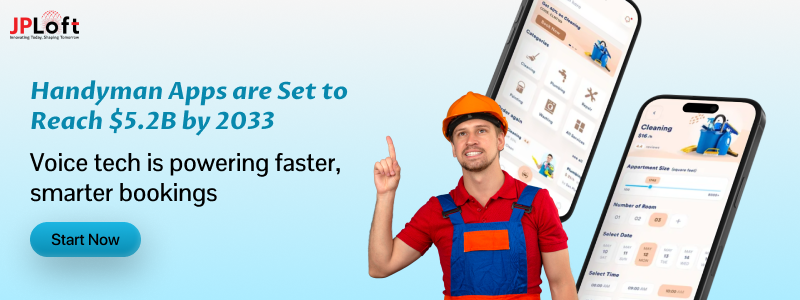
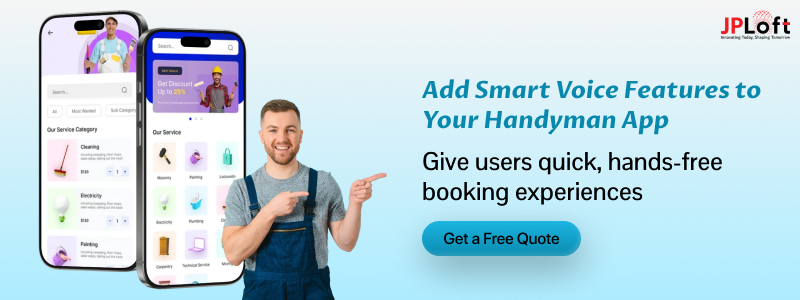

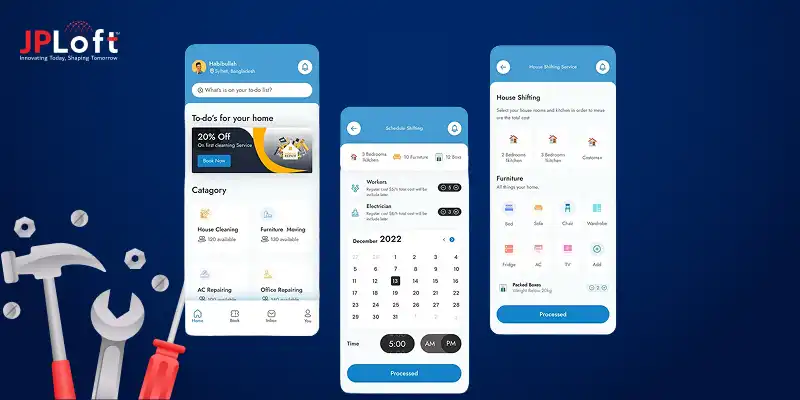
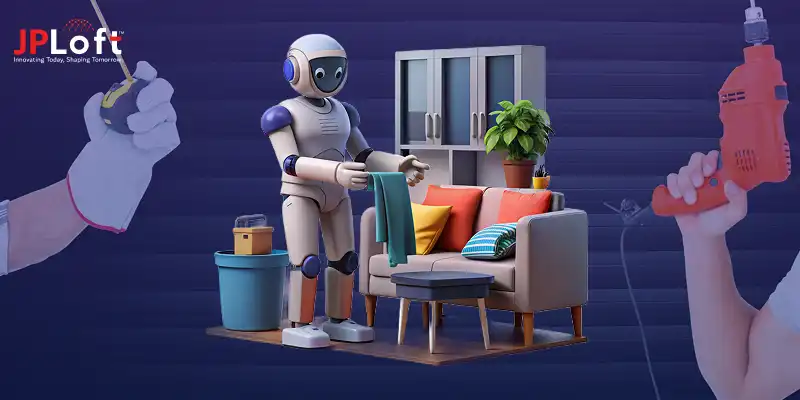
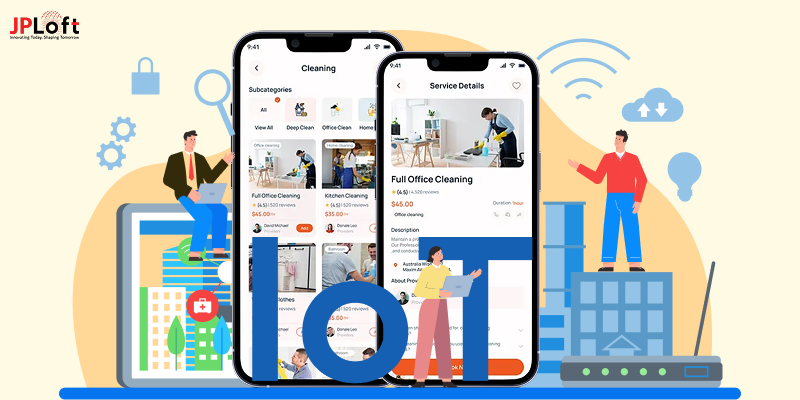


Share this blog